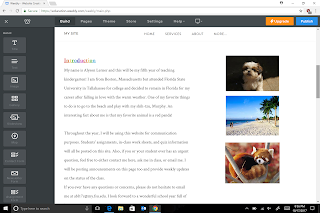Blog Journal 5
In my opinion, Web 2.0 technologies can be very helpful in classrooms. Although web usage definitely depends on age and maturity level, I think Web 2.0 technologies are great. One Web 2.0 technology the podcast discusses is Diigo. Even though I do not have much experience with Diigo yet, it seems interesting. I find it beneficial that students are able to post notes directly on online readings and easily communicate with their teacher if necessary. If students have the opportunity to easily ask questions, I think they are more likely to which helps both the teacher and the students further understand the topic. Another Web 2.0 technology mentioned in the podcast was blogs. Blogs allow students to publish their own writing online. Also, if the student wants the blog to only be seen by the teacher, they are able to make privacy settings which protects the individual. One Web 2.0 technology that I might not use in a classroom is Twitter. Even though I find Twitter to be very useful, I think it is easy for students to get distracted on it or find irrelevant material. Therefore, in a class with immature students, it might not be the best technology to use.
One interesting Web 2.0 tool that I think I would use for teaching is Pinterest. Pinterest could provide inspiration for classroom decorations or lessons, fun ideas for class games, and communication with other teachers across the globe. As a past user of Pinterest, I believe it is very useful and I would definitely encourage people to use it as it provides easy and fun ideas for almost anything from hair styles to cooking to lesson plans for teachers!
Link: https://www.pinterest.com/
The technological advancement mentioned in Chapter 12 that I think holds the biggest promise for education is electronic paper. Electronic paper is unbreakable, flexible, environmentally friendly, convenient, and cheap. Since I am aiming to be a first or second grade teacher, I will probably hand out many worksheets. If these worksheets were given electronically, I would save paper and keep organized. Also, as a student, I use a lot of paper each day for notes, scrap work, and assignments. If I did all of these things on electronic paper, I would have much less to carry and help the environment. Overall, I think the implementation of electronic paper in classrooms could bring along great change.
One interesting Web 2.0 tool that I think I would use for teaching is Pinterest. Pinterest could provide inspiration for classroom decorations or lessons, fun ideas for class games, and communication with other teachers across the globe. As a past user of Pinterest, I believe it is very useful and I would definitely encourage people to use it as it provides easy and fun ideas for almost anything from hair styles to cooking to lesson plans for teachers!
Link: https://www.pinterest.com/
The technological advancement mentioned in Chapter 12 that I think holds the biggest promise for education is electronic paper. Electronic paper is unbreakable, flexible, environmentally friendly, convenient, and cheap. Since I am aiming to be a first or second grade teacher, I will probably hand out many worksheets. If these worksheets were given electronically, I would save paper and keep organized. Also, as a student, I use a lot of paper each day for notes, scrap work, and assignments. If I did all of these things on electronic paper, I would have much less to carry and help the environment. Overall, I think the implementation of electronic paper in classrooms could bring along great change.

Comments
Post a Comment